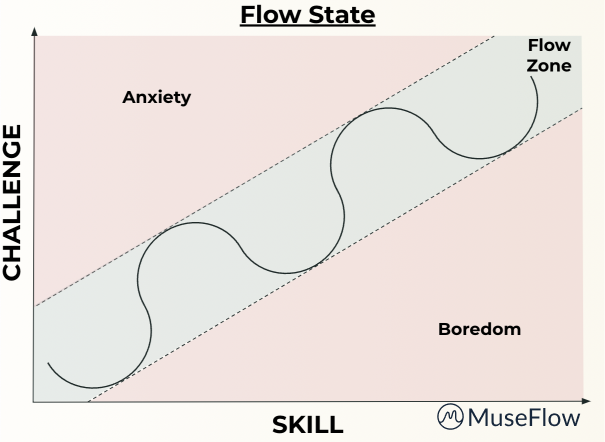What is the Best Piano Learning Software for MIDI? Discover MuseFlow
Digital music education keeps getting better and finding the right software to learn piano, especially with a MIDI keyboard, will make a huge difference in your musical journey. As you might know, MIDI keyboards offer flexibility and a range of features that can enhance your learning experience... So, what is the best piano learning software for MIDI? The answer is MuseFlow. Find 5 quick reasons why the California-based startup is the best option:
1. Personalized Learning with Data
MuseFlow uses of advanced data-driven techniques to personalize your learning experience. Unlike traditional old-school learning methods that follow a rigid curriculum, the software adapts to your unique needs and your progress. It's 2024, that means the app is able to assess your current skill level & learning style, while continuously analyzing your performance. It then adjusts the difficulty of the exercises accordingly. How amazing is that? This really makes sure that you are always working on tasks that promote personal growth without being overwhelming. The goal is to get you into your flow state so that you can stay engaged and motivated. We live in a fortunate time where technology is to take learning to unbelievable heights. AI is really revolutionizing education and it should be embraced for that.

2. Real-Time Feedback & Personalized Error Correction
Real-time feedback is super important when learning an instrument! This innovative new software provides real-time feedback on your playing. This helps you correct mistakes instantly. As you learn to play your MIDI keyboard, MuseFlow listens to your performance and provides instant feedback on your accuracy, your timing, and your unique technique. This feedback is displayed in an easy-to-understand format, so that you can easily and exactly see where you need to improve. A human piano teacher cannot do it as efficiently. Now if you are a beginner, this can be even more beneficial. To understand more about the benefits of real-time feedback in learning and how it's the best way to excel your personal journey, you can read this insightful piece from EduMe.

3. Engaging & Fun Learning Experience
Learning piano should be fun and enjoyable! Nobody wants to learn the Midi keyboard and be frustrated along the way. The learning software for Midi keyboards makes sure of that by adding gamification levels, your learning becomes a more fun process...This means your practice sessions feel more like playing a game than studying. If you know the App Duolingo then you know how much users want to continue learning a language. And music is a language in and of itself! MuseFlow includes fun features such as progress bars, achievement badges, and interactive challenges. With each completed lesson you improve your skills and you also earn rewards and move up levels. This new-school gamified approach keeps you motivated and makes piano practicing fun.

4. Extensive Library of Music & Exercises
This innovative piano learning software for Midi keyboards offers a great personalized library of songs and exercises. The goal is to cater to all skill levels and musical tastes. This huge collection of music makes sure that you always have something new and exciting to learn! Don't get stuck on the same old songs and star hating them.. this software provides access to hundreds of music pieces, from classical to contemporary, and many different fun exercises made to improve different aspects of your playing. The library is of course regularly updated, so there’s always fresh content for you to explore. The piano learning app lets you choose from your favorite genres and styles, so that you develop a well-rounded skill set. A lot of the 5-star reviews say that it's the best midi piano learning software, because of the extensive library! Every week new featuers & improvements are made to the software, to make sure you'll keep having the best possible experience.

5. Midi Piano Lessons - Flexibility & Convenience
One of the biggest advantages of learning to play the piano with MuseFlow is its flexibility. Why? Because you can practice your Midi keyboard lessons whenever it fits into your schedule. Whether you have 15 minutes during your lunch break or some quiet time late at night, you decide when to learn. Sometimes you have a session with a piano teacher but are just really not in the mood or don't have time so you have to cancel the appointment. With this Midi piano learning software you’re not tied to a fixed schedule. You can fit piano practice into your busy life, making it easier to stay consistent. The app’s structure also allows you to pick up right where you left off, so every minute of practice is effective. This will help you stick to your practice routine consistently, which is really really important for steady progress.

Conclusion
Customers love MuseFlow, and it really stands out as the best piano learning software for MIDI keyboards. Its AI-driven personalized learning paths make sure that your lessons are tailored to your own specific and personalized needs. The real-time feedback feature helps you correct mistakes instantly, and it promotes proper technique and faster improvement. The modern gamified learning experience makes practicing fun and engaging, so you will always stay motivated. Last but not least, the extensive library of music and exercises offers the best opportunities for growth and exploration. Try MuseFlow today and experience the best way to learn piano with your MIDI keyboard. Happy playing!


.svg)

.jpg)










